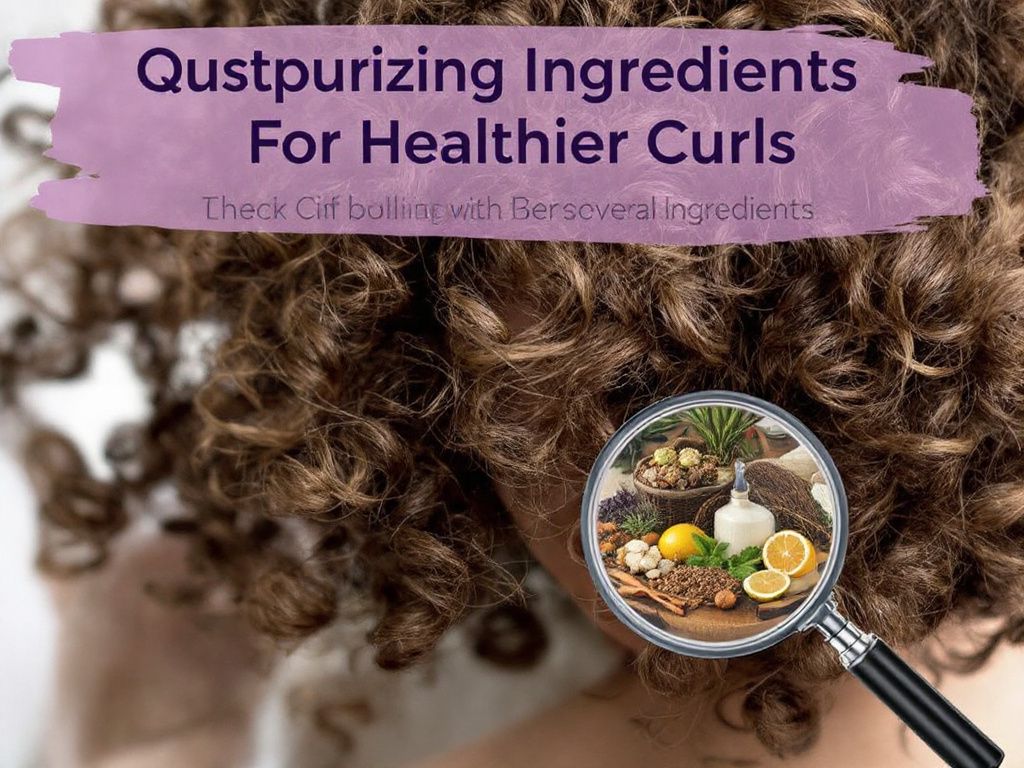
The world of curly hair care is intricate and vibrant, just like the spirals it caters to. Adorning a head of curls isn’t merely genetic luck; it’s a delicate dance of products, patience, and persistence. However, what if the very products meant to define and enhance are, in fact, detrimental? As curly-haired aficionados strive for luscious locks, they may not realize the chemical cocktail they’re swiping over their strands. Here’s the inside scoop on what the labels aren’t divulging about curly hair product ingredients. 🕵️♀️
Unmasking the Ingredient Suspects
Navigating the list of ingredients on curly hair products might feel like deciphering a complex code, with the language usually dominated by Latin terminology and scientific jargon. It’s crucial to see past the disguise and unmask the potential culprits lurking within.
1. Sulfates: The Stripping Agent
Sulfates, such as sodium lauryl sulfate (SLS) and sodium laureth sulfate (SLES), are powerful detergents that provide that familiar lathering effect in shampoos. While they may seem beneficial in cleansing hair, they often strip natural oils, vital for maintaining curl integrity, resulting in dry and brittle hair. 📉
**Case Study:** The International Journal of Trichology highlighted that sulfate-based products increase skin permeability. This increase can lead to scalp irritations, especially harmful for individuals with sensitive curly hair.
For effective sulfate-free alternatives, products using gentle cleansers like sodium lauroyl methyl isethionate can be considered. They maintain a healthy and balanced scalp environment without sacrificing moisture.

2. Silicones: The Artificial Smoothness
Silicones are designed to coat the hair, providing a sleek and shiny appearance. However, the non-water-soluble variants, such as dimethicone and cyclopentasiloxane, prevent moisture from penetrating the hair shaft, exacerbating dryness over time.
**Expert Analysis:** According to haircare experts, silicons build-up forms a barrier, effectively blocking nourishing substances like vitamin E and natural oils, crucial for curl health. Silicone-free options, namely those utilizing plant oils such as argan or jojoba oil, inject necessary hydration and nutrition into curls without relying on artificial film formers.
3. Parabens: Preservation Perils
Parabens (e.g., methylparaben, propylparaben) act as preservatives, extending product shelf life. However, their potential to disrupt hormonal balance has sparked concern, given their ability to mimic estrogen. 💢
**Scientific Data:** A study featured in the Journal of Applied Toxicology demonstrated a direct correlation between paraben exposure and increased concentrations of the chemical in breast tissue samples. This link has nudged both consumers and product developers toward exploring paraben-free formulations, thus easing endocrine concerns.
4. Alcohols: Moisture Vampires
Avoidance doesn’t mean all alcohols; fatty alcohols like cetyl or stearyl alcohol benefit by providing smoother, softer hair. Instead, consumers should be vigilant about avoiding short-chain alcohols (such as isopropyl alcohol) that can dry out curls.
**Research Insight:** Prof. Jessica Krant, dermatology, underlined that volatile alcohols in styling products evaporate quickly, causing the surrounding environment—your strands—to lose moisture. To soothe this effect, focus on formulations known for glycerin or panthenol, which attract and retain moisture effectively.

5. Artificial Dyes and Fragrances: The Unseen Irritants
Notorious for causing allergic reactions and sensitivity, synthetic dyes and fragrances have no benefits aside from visual appeal and scent. They are primary irritants, particularly problematic for sensitive scalps and brittle curls.
**Industry Standards:** The Environmental Working Group (EWG) suggests sticking to safer fragrance derivatives labeled as “fragrance-free” or those scented naturally through essential oils like lavender or rosemary.
Deciphering and Elevating Your Curly Hair Routine
Spotting harmful curly hair product ingredients to avoid can transform not just the health of your hair but the health of your mindset concerning hair care. Here’s a quick guide toward more achievable and cleaner curl maintenance:
Ingredient Analysis: The Read-Up Approach
- Read every component, even those falling last in the ingredient list.
- Research unfamiliar terms online to uncover potential toxic impacts.
- Reach out to brands—seek clarifications readily as part of responsible consumerism.
Natural Ingredients: The Curl Savior
Tapping into nature’s wellspring offers numerous safe and effective substitutes. Look for clean curly hair products prioritizing elements like-aloe vera, enriched plant extracts from avocado or olive, and protein infusions from grains or seeds such as quinoa or flaxseed. 🌱

**Practical Tips:**
- Regularly hydrate your curls with deep-conditioning masks crafted from natural butters like shea or mango.
- Focus on lightweight oils to fight frizz without adding unnecessary weight or clog.
- Stay wary of product overload; simplicity often prevails in avoiding irritation and fatigue within the curls’ ecosystem.
Future Prospects in Transparent Curl Care
As the global demand for clarity accelerates, the haircare industry leans greener and cleaner. With regulatory bodies tightening criteria and watch groups like EWG budding globally, it’s evident: consumers now wield substantial influence in determining which products prevail.
Released whitepapers from companies leading the charge in innovation highlight the emergent clean and natural product lines prioritizing safety, minimal processing, and sustainability, foretelling a future where labels will reveal all and curls finally have entrusted protectors.
Conclusion
Divulging the truth behind harmful curly hair product ingredients turns previously passive consumables into monumental advocacy movements championed by informed beauty stewards of today. By uncorking knowledge, everyone possessing curls, from soft waves to bouncy coils, holds power over their products and, more so, their ingredients.
Embrace a regimen that promises transparency—your curls will rise to extraordinary heights of health and homogenous harmony. 💪✂️ Embrace the transformation, starting with conscious, clean choices that uplift both your hair and the larger ecosystem nourishing it.
Frequently Asked Questions
What are the benefits of using a hair mask in my hair care routine?
Using a hair mask can provide several benefits, including hydration, smoothing, strengthening, curl definition, heat protection, and damage repair. Hair masks infuse the hair with moisture, help coat the hair shaft to seal split ends, reduce breakage, and protect the hair from heat styling and environmental damage[1][4].
What ingredients should I look for in a hair mask?
Effective hair masks often include ingredients such as coconut oil, argan oil, shea butter, honey, avocado oil, green tea, and coconut water. These ingredients provide nourishment, moisturize, and protect the hair, offering benefits like softening, moisturizing, and protecting against damage[2][5].
How often should I use a hair mask in my routine?
You should use a hair mask whenever your hair feels dry, unmanageable, or in need of intense hydration. This can vary depending on your hair type and needs, but generally, using a hair mask once or twice a week can help maintain healthy and moisturized hair[1][4].
How do I apply a hair mask for the best results?
To apply a hair mask effectively, shampoo your hair first, then apply the mask, focusing especially on the ends where hair tends to be the most damaged. Leave the mask on for anywhere from 10 minutes to overnight, depending on the type of mask and your hair’s needs[1][4].
References

Leave a Reply